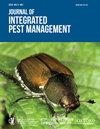Evaluating a decade (2011–2020) of integrated forest pest management in the United States
IF 2.7
3区 农林科学
Q1 ENTOMOLOGY
引用次数: 0
Abstract
Abstract To sustain healthy forests in the United States, the USDA Forest Service, Forest Health Protection and cooperators utilize integrated pest management (IPM) programs to prevent, suppress, and eradicate insect and disease outbreaks affecting trees across all land ownerships. Forest pest management projects supported by federal funding from 2011 to 2020 were assessed to determine the most frequently used project types, IPM strategies and tactics, identify the dominant forest pests and associated hosts managed, and identify the most comprehensive forest IPM programs in practice. Forest pest management projects were obtained primarily from two centralized databases and included 2,416 projects that treated a total of 2,284,624 ha. Two project types accounted for most of the forest pest projects (suppression: 63% and prevention: 30%). Native forest pests were targeted more (79%) than non-native pests (21%) in these projects; however, non-native pests accounted for more treatment areas. Forest pest projects were directed mostly at phloem-feeding insects (70%) and subsequently followed by foliage feeders (10%), sap feeders (6%), and all other pest groups (each < 5%), including diseases. Four IPM control strategies (silvicultural: 32%, semiochemical: 22%, chemical: 21%, and physical/mechanical: 18%) accounted for most of the forest pest projects. Foliage feeders possessed the most comprehensive IPM programs that adopted two or more types of control tactics. Few pest programs incorporated microbial/biopesticide control strategies and this represents an area where research is needed. In addition, better-centralized records are needed for genetic control projects, treatment efficacy, and survey and technical assistance activities.评估美国森林病虫害综合治理十年(2011-2020年
为了维持美国的健康森林,美国农业部林业局、森林健康保护和合作伙伴利用综合虫害管理(IPM)项目来预防、抑制和根除影响所有土地所有权树木的虫害和疾病爆发。对2011 - 2020年联邦资助的森林有害生物治理项目进行了评估,以确定最常用的项目类型、IPM战略和策略,确定主要的森林有害生物和相关宿主,并确定实践中最全面的森林IPM计划。森林有害生物治理项目主要从两个中央数据库获得,包括2,416个项目,共处理2,284,624公顷。两种项目类型占森林有害生物项目的大部分(抑制占63%,预防占30%)。在这些项目中,原生森林害虫(79%)比非原生森林害虫(21%)更受关注;然而,非本地害虫占更多的处理面积。森林害虫项目主要针对韧皮部取食昆虫(70%),其次是叶食性昆虫(10%)、树液食性昆虫(6%)和所有其他害虫类群(每个<5%),包括疾病。四种IPM防治策略(造林:32%,符号化学:22%,化学:21%,物理/机械:18%)占森林有害生物防治项目的大部分。叶食性昆虫拥有最全面的IPM程序,采用两种或两种以上的控制策略。很少有虫害防治项目采用微生物/生物农药防治策略,这是一个需要研究的领域。此外,遗传控制项目、治疗效果、调查和技术援助活动需要更好地集中记录。
本文章由计算机程序翻译,如有差异,请以英文原文为准。
求助全文
约1分钟内获得全文
求助全文
来源期刊

Journal of Integrated Pest Management
Agricultural and Biological Sciences-Insect Science
CiteScore
5.80
自引率
3.60%
发文量
24
审稿时长
25 weeks
期刊介绍:
Journal of Integrated Pest Management is an open access, peer-reviewed, extension journal covering the field of integrated pest management. The Editors-in-Chief are Dr. Marlin E. Rice (formerly with Iowa State University) and Dr. Kevin L. Steffey (formerly with the University of Illinois). The journal is multi-disciplinary in scope, publishing articles in all pest management disciplines, including entomology, nematology, plant pathology, weed science, and other subject areas.
 求助内容:
求助内容: 应助结果提醒方式:
应助结果提醒方式:


